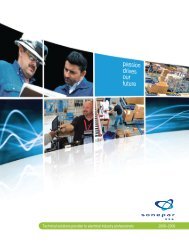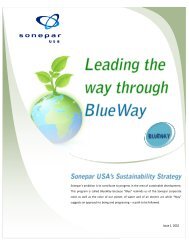Create successful ePaper yourself
Turn your PDF publications into a flip-book with our unique Google optimized e-Paper software.
BEST PRACTICES<br />
Continued from page 31<br />
training was rolled out in early 2005, beginning<br />
with all managers—including the<br />
CEO, CFO, presidents, vice presidents,<br />
branch managers, and supervisors.<br />
“We found that the No. 1 determinant of<br />
success or failure of any educational program<br />
was the level of participation of the<br />
management,” said Tim McGowan, director<br />
of process management and training. “The<br />
one absolutely essential element is the total<br />
buy-in of every manager in the company.”<br />
As a manager, Hensley helps his people<br />
make time. “I’ve had several people tell<br />
me, ‘I can’t go to the training; I’ll have to<br />
reschedule.’ I tell them that’s not an option.<br />
My job is to help everyone participate,<br />
even if that means rearranging schedules<br />
to get that job done.”<br />
Managers grow people<br />
Training in what educators commonly<br />
refer to as soft skills—those difficult-toquantify<br />
behaviors like communicating,<br />
problem solving, and active listening—is<br />
the crux of the <strong>CLS</strong> training called Interpersonal<br />
Management Skills (IMS). These<br />
skills include how to open a conversation,<br />
how to clarify and confirm what was<br />
heard, how to deal with situations where<br />
there is disagreement, and how to credit<br />
another’s input.<br />
“A manager doesn’t get paid for current<br />
Tim McGowan,<br />
director of process<br />
management and<br />
training. David Wolfe<br />
in the background.<br />
decisions,” said McGowan. “Managers get<br />
paid for the impact their current decisions<br />
have on future results.”<br />
“The IMS training program gives our<br />
managers the confidence to develop<br />
people—to grow the individuals who will<br />
replace them when they move up or retire,”<br />
said Mike Bourn, president of the<br />
Southern Division.<br />
Hensley has worked for <strong>CLS</strong> for four<br />
years and can prove that the company is<br />
growing its own people. “Recently, we had<br />
to replace four people in one of our locations<br />
within a very short period,” he said.<br />
“Instead of having to find people from outside<br />
to populate that store, we were able to<br />
hire from within. That would never have<br />
happened two years ago.<br />
“This tells me that we’re on the right<br />
track,” he continued. “You have to have<br />
your own farm team. Successful businesses<br />
have a deep bench to draw from.<br />
“This is a major success not only for our<br />
company, but also for our people,” he<br />
added. “One of the workers we’ve put<br />
behind the counter was in the warehouse<br />
two years ago. He came to me the other<br />
day and told me to look out the window at<br />
the parking lot; I saw a brand new car.<br />
“That’s what developing the individuals<br />
within your company is all about—he’s<br />
proud of his car, he’s proud of his job, and<br />
he’s building a career,” he said.<br />
Investing in people<br />
32 T H E E L E C T R I C A L D I S T R I B U T O R ■ J A N U A R Y 2 0 0 7 ■ w w w . t e d m a g . c o m<br />
“Three components make up our business:<br />
time, money, and people,” said<br />
Bourn. “Given that this is such a people<br />
business, if you’re spending your money<br />
on your people, they’re going to pay you<br />
back with time.”<br />
Sure, it’s expensive. <strong>CLS</strong> not only pays<br />
for the three-day, off-site training in soft<br />
skills, but also encourages everyone to<br />
take work time to access online courses<br />
they need to get closer to error-free<br />
processes and service delivery.<br />
“All of the people involved in our industry<br />
have a choice, including our employees,”<br />
noted Hardy. “We don’t forget<br />
that all of the people with whom we interact<br />
have the discretion to choose whether or<br />
not to have a relationship with us. The key<br />
for us is to create an organization that<br />
allows people to grow, encourages them to<br />
grow, and has accessible resources in<br />
place for them to choose to grow.”<br />
It becomes quite energizing for a group<br />
of people to fully understand that their<br />
company is willing to invest substantial<br />
resources in them.<br />
McGowan mentioned that the company<br />
recently provided training for its drivers in<br />
the course Providing Stellar Customer<br />
Service/Healing Customer Relationships.<br />
“We gathered 62 drivers in four locations<br />
on a Saturday,” he said. “They<br />
walked in wondering what they were doing<br />
there. By the end of the day, we had to<br />
kick them out; they were so energized.”<br />
Jerry Kelly, Baltimore warehouse supervisor,<br />
said, “I learned that my people<br />
have a lot more problem-solving skills than<br />
I had given them credit for. They had good<br />
ideas and asked for tools to help keep the<br />
customer satisfied—for example, having<br />
giveaways on hand to help smooth a<br />
touchy situation. That was something I’d<br />
have never thought of.”<br />
“Helping every person at the company<br />
feel involved and valuable is the investment<br />
we’re making,” added McGowan.<br />
“We’re already seeing a return on that<br />
investment in terms of loyalty, morale, error<br />
reduction, and productivity.”<br />
Results offer proof<br />
The old adage is that “change is hard.” In<br />
many respects, that’s true. But change<br />
also keeps a company vibrant, alive, and





